27 Dec 2022
Words
Christine Retschlag Informer 105
We Bought a Zoo
After a stellar two-decade career in residential real estate in our nation’s capital, Richard Tindale and his family decided to go left field and buy a zoo.
Since then, they haven’t looked back, turning a business in receivership into one of our country’s best wildlife arenas, the award-winning National Zoo and Aquarium and the adjacent Jamala Wildlife Lodge where guests can literally live among the animals. We spoke to Richard about what makes a great zoo, and how he transitioned from corporate life to wildlife.
How did you end up buying a zoo?
Our family has always had a passion for animals, so my wife Maureen, our kids (all in their twenties then) and I decided to do something with animals. After 20 years in the residential real estate and building industry, I was keen on something else.
I sold my businesses in the mid ‘90s and we travelled the world to fulfill a dream of seeing big cats in the wild. It was obvious there were very few left and that their numbers were declining.
I knew the National Aquarium was in receivership, so we decided to buy it as it had 8 hectares that could be developed into a zoo.
We renamed it the National Zoo and Aquarium in 2000. In 2008, the local government gave us an adjoining 18 hectares to expand the zoo and we added an open range section.
What did you hope to achieve as a zookeeper?
Our initial aim was to build a facility for breeding endangered big cats as part of the regional and world breeding programs.
All our six children either joined as staff or assisted in other ways as we set about gaining credibility in an industry that is rightly concerned about owner’s intentions towards the animals in their care.
We and our staff are here for the right reasons. We have one primary concern — to care for the animals.
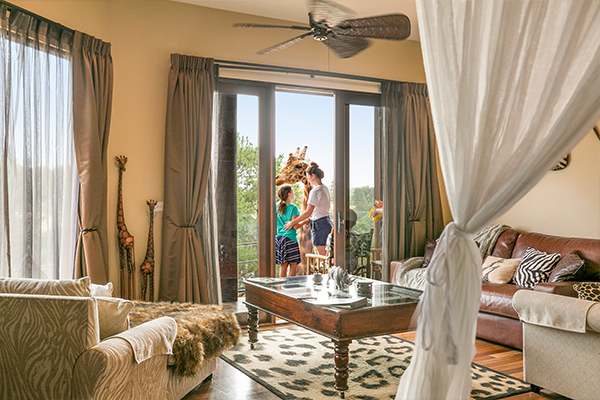
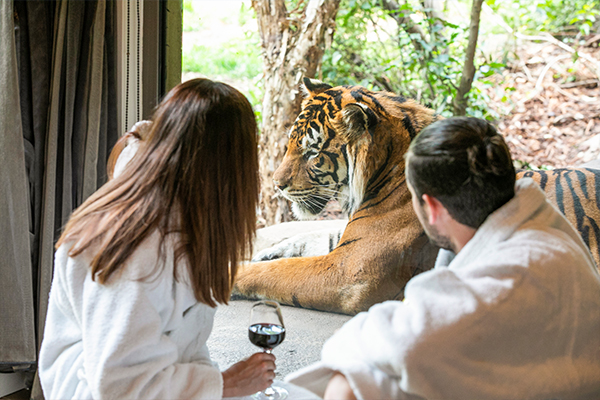
How many animals does the zoo have, and what kinds are they?
We have around 340 animals and around 90 habitats for them. We have approximately 300 water creatures in the aquarium alone.
The zoo and aquarium have an amazing range of animals from every continent: giraffes, zebras, lions, tigers, leopards, cheetahs, monkeys, otters, meerkats, penguins, sun bears, birds, native animals, freshwater and ocean fish, sharks, eels, frogs, snakes and lizards.
It’s the most diverse range of animals in Australia, and very few facilities in the world have such diversity.
A number are categorized as either “threatened” or “critically endangered” and many are part of industry breeding programs.
Do you have a favourite animal?
Very hard to choose a favourite, but my relationship with the white lions, Jake and Mischka, is very special. We bonded immediately.
We took them on as it was likely they would end up in an under-resourced zoo. They’ve been here 12 years and like most of our animals they’ve formed a very deep connection with their keepers.
How does Jamala Wildlife Lodge fit into the picture?
Our role as a zoo is to not only try to keep endangered species alive but to help educate the public to preserve and protect their habitat in the wild. It’s also the responsibility of zoos to contribute directly to their conservation.
Jamala was established to assist the zoo with those objectives. Our zoo signs are very informative, but the greatest impact on our visitors’ buying into animal conservation is by getting them close to the animals and explaining their situation.
Our enclosures are large by urban zoo standards, so it’s not always possible to get them close to all the animals. Because of this, we have multiple habitats for many species.
For example, if you don’t see a tiger in one habitat, there are four other habitats where you’re likely to see at least one up close. Our greatest impact on visitors is when they do a tour or encounter.
They not only get close to the animals, but we impress upon them how they can help them in the wild. The animals are never restricted from moving away and that’s the benefit of having multiple habitats. If one animal isn’t keen, we can try another habitat.
Apart from financially supporting the zoo, which was never set up with commercial objectives, Jamala takes the animal experiences to the next level. You only need to read our guests’ feedback to realise the incredible impact the experience has on them. So many of our guests leave with an acute awareness of how they can help with conservation.
What’s the lodge experience like?
Jamala has 18 rooms, all with a different character. Guests can choose to stay in a Jungle Bungalow that looks directly onto the habitat of lions, tigers, cheetahs or sun bears. The animals have full access to their large enclosures, but they nearly always choose to spend time right next to the windows of the bungalows. A full night’s sleep is sometimes not on the cards with lions or tigers at your window!
Guests can also opt for a Giraffe Treehouse, where they can handfeed two of our beautiful giraffes from their balcony. There’s also the uShaka Lodge, which has seven rooms and suites situated with a shark tank in the main area. The rooms and lounge/dining areas are decorated with magnificent carvings and artwork from right across Africa.
The rooms offer options of meerkats or monkeys outside your room, a room with a 5m-high ocean aquarium as one window with the other overlooking the hyenas, a two-bedroom suite where guests meet the sharks from their terrace, or a room that includes an encounter with our three young cheetah brothers in their habitat. Everything including tours, afternoon tea, breakfast and a four-course gourmet meal with fine wines and Moet Champagne.
All guests get to meet our white lions and hyenas during pre-dinner drinks, and they then dine in either the Rainforest Cave or in an area adjoining the shark tank.
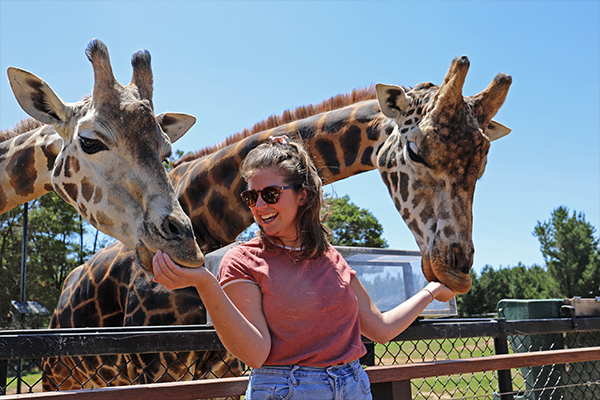
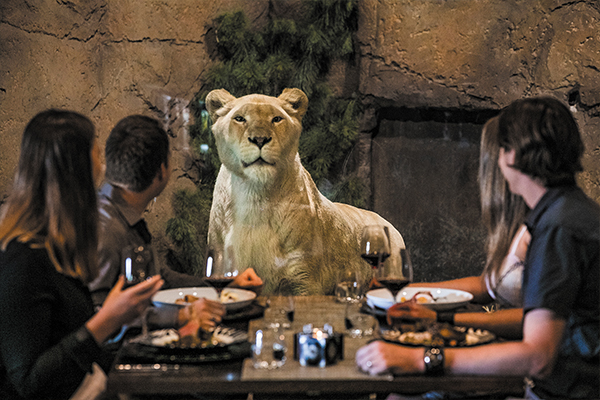
How does Jamala help the animals?
Funds raised from Jamala are primarily used to subsidise the zoo operations, allowing it to continue to expand and evolve.
The funds also support conservation in the wild, help animal welfare causes, and support numerous charities and people in need.
During the last three years, Jamala and the zoo have donated more than $1,000,000 to these causes.
How has the zoo added to the Canberra tourism experience?
The zoo and Jamala add a new dimension to the other fantastic tourist experiences available in Canberra. Both facilities have a tremendous appeal to all of the community — children, adults, grandparents, families and those fulfilling a bucket list. The experiences are regarded as a combination of fun, education, adventure, luxury and helping conservation.
What was your biggest challenge with opening Jamala?
We were confident the public would support the concept and take advantage of the amazing experiences, while at the same time assisting the animal world.
We were also confident that the animals would want to interact with guests as we have had 20 years watching and anticipating their reactions.
The challenges were getting the whole experience to be at a 5-star level and to maintain that every single day. We impress on our staff that some of our guests are only here for a day, so we have to get everything right every day for all guests to have the ultimate experience, as we don’t get a second chance.
What’s been your greatest success?
Definitely the positive feedback from our guests. Their praise of the entire experience, including the tour, rooms, lodge, decor, artworks and atmosphere, along with many rating our dining as the best they’ve experienced — this makes it all worthwhile. However, the greatest success is the accolades they give our staff at both Jamala and the zoo.
Our other great successes include the breeding programs, the impact we have on animal conservation and welfare through people’s experiences, the donations that we make and just as importantly, the excitement and amazement we see on visitors’ faces.
Our membership has grown from 5,000 to 25,000 in the last few years and we love to see adults and children visiting every week and learning about the importance of the animal kingdom.
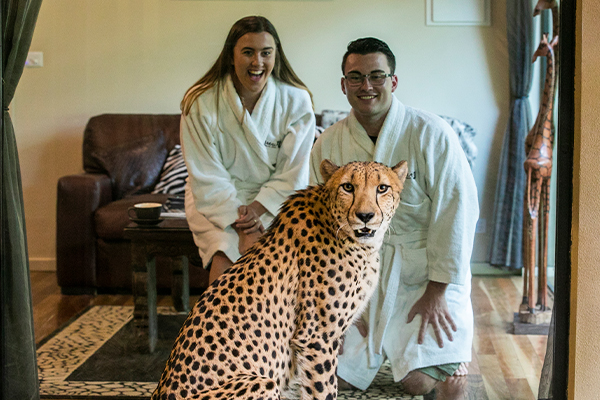
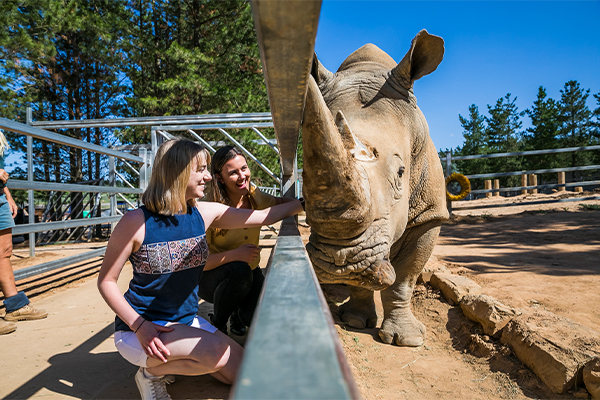
What are your future plans for the zoo?
We’re continually looking at ways to make an amazing experience even more amazing.
The zoo is always evolving, and we have a few new suites about to open. We already have what we believe to be one of the country’s best playgrounds, with 50 activities plus 55 replica animals for kids to either play on or discover.
We’re about to extend the playground’s size and facilities by 50 percent, and to ensure the kids get out of the playground and meet our animals we have started a Discovery Trail that gives them activities and learning opportunities as they travel between viewing areas.
Due to the large size of the enclosures, this can sometimes be a reasonable distance, so the Trail gives them great opportunities to discover new things as they go. We’re also installing ZooArt, which incorporates some magnificent artwork, carvings and photos from around the world.
Any advice for budding zoo owners?
Animals, particularly zoo animals, aren’t a business — they’re a passion and a commitment. Only consider getting into it if you’re doing it for the right reasons — the animals, not your bank balance. END
